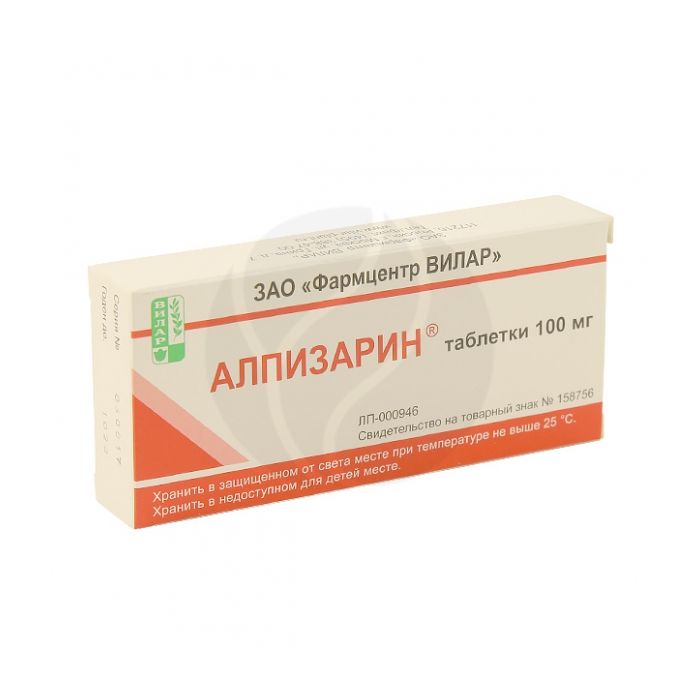Alpizarin tablets 0.1g, No. 20
Expiration Date: 05/2027
Russian Pharmacy name:
Алпизарин таблетки 0,1г, №20
As part of the combined therapy of acute and recurrent infections caused by the herpes simplex virus of various localization (including genital);
viral diseases of the oral mucosa (aphthous stomatitis),
shingles,
Kaposi's herpetiformis eczema,
cytomegalovirus infection,
chickenpox.
Inside, regardless of food intake, adults and children over 12 years old - 1-2 tables. 3-4 times a day; children 6-12 years old - 1 table. 2-3 times a day; children 3-6 years old - 1 / 2-1 table. 2-3 times a day.
The therapeutic effect of the drug is most pronounced when administered in the initial period of the disease. The duration of treatment depends on the form and severity of the disease.
In the case of common rashes in acute and recurrent forms of herpes simplex, both genital and extragenital localization, as well as in the presence of fever, lymphadenopathy and other general phenomena, the drug is used for 5-14 days; with Kaposi's herpetiform eczema and CMV infection - within 7Ц21 days as part of complex therapy; for aphthous stomatitis, the drug is prescribed for 5-15 days; for diseases caused by Herpes zoster (shingles) and Varicella zoster (chickenpox) - within 5Ц21 days.
In case of relapses, repeated courses of drug treatment are carried out. For the prevention of recurrence of herpesvirus infections, the drug is prescribed one month after the end of treatment for 10-14 days.
The maximum daily dose of the drug for children over 12 years old and adults is 800 mg (table 8), for children 3-12 years old - 300 mg (table 3).
Pills
1 tab.
tetrahydroxyglucopyranosylxanthene 100 mg
Hypersensitivity to the components of the drug.
Pregnancy.
Children under 3 years old.
Lactase deficiency, lactose intolerance, glucose-galactose malabsorption.
With care: breastfeeding period.
pharmachologic effect
Alpizarin has antiviral activity against viruses: Herpes simplex types 1 and 2, Herpes zoster, Varicella zoster, cytomegalovirus. In vitro experiments have shown the inhibitory effect of tetrahydroxyglucopyranosylxanthene against the human immunodeficiency virus.
The inhibitory effect of the drug on the reproduction of the virus is especially evident in the early stages of its development. Alpizarin does not affect the activity of viral neuraminidase.
Alpizarin has immunostimulating properties in relation to cellular and humoral immunity, the ability to induce the production of interferon gamma in blood cells.
Alpizarin inhibits the growth of gram-negative (Escherichia coli) and gram-positive (Staphylococcus aureus, Mycobacterium tuberculosis) bacteria, fungi (Microsporum canis) and pathogenic protozoa (Entamoeba histolytica, Trichomonas vaginalis). The mechanism of action of the drug is based on the ability to suppress the activity of bacterial nuclease. Alpizarin has a mild anti-inflammatory effect.
Pharmacokinetics
The drug, when taken orally, is rapidly absorbed from the gastrointestinal tract.
In blood plasma, unchanged tetrahydroxyglucopyranosylxanthene is determined within 0.5-5 hours after application.
The maximum concentration of tetrahydroxyglucopyranosylxanthene - 4.5 ?g / ml is achieved 1 hour after its application.
Tetrahydroxyglucopyranosylxanthene binds to a large extent with blood proteins (90-70%).
Extrarenal routes of excretion of tetrahydroxyglucopyranosylxanthene predominate. Excretion of unchanged tetrahydroxyglucopyranosylxanthene by the kidneys within 24 hours does not exceed 0.1%.
Side effect
Allergic reactions are possible.
Application during pregnancy and lactation
There is no data on the release of tetrahydroxyglucopyranosylxanthene into breast milk, therefore, the use of the drug during breastfeeding is possible only for health reasons, if the intended benefit to the mother outweighs the potential risk to the child. A doctor's consultation is required.
With care: breastfeeding period.
Application in children
Contraindicated in children under 3 years of age. It can be used in children over 3 years of age according to indications.
special instructions
In the case of common rashes, as well as in the presence of fever, lymphadenopathy and other general phenomena, use the drug Alpizarin tablets 100 mg in combination with the drug Alpizarin ointment for external and local use 2% and 5%.
1 tablet of the drug contains 0.1 g of milk sugar (lactose) and 0.0475 g of potato starch, which corresponds to 0.01 XE (bread units). The maximum daily dose of the drug for children from 3 to 12 years old contains 0.03 XE; for children over 12 years old and adults - 0.08 XE.
Influence on the ability to drive vehicles and mechanisms
The drug does not affect the performance of potentially hazardous activities or requiring increased concentration of attention and speed of psychomotor reactions (driving and working with moving mechanisms).
Overdose
To date, no cases of overdose have been reported. Overdose is unlikely.

